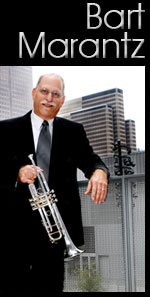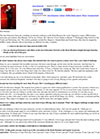 Home B.M.P. BTWHSPVA Articles Interviews Reviews Books Biography Videos Photos Calendar Music Links Contact Sara Marantz Matt Marantz Luke Marantz
Bart Marantz NPR/KERA Jazz Education Interview    Click below to listen to the interview  Click below to read the article 
|
Reviews “Swingin’ Shanty" Written: Traditional Arranged: Ralph Ford Instrumentation: Big Band Publisher: Alfred / Belwin Jazz *First Year Charts Series Grade 3 Swing q = 132-152 $44.00 Here’s a little background on the melody this chart is based on. “What Do You Do With A Drunken Sailor?” is a famous capstan or “heaving” shanty. Sea shanties are songs that were sung by sailors in rhythm with their work. The word is thought to be derived from the French word chanter, meaning, “to sing.” Although the chart is marked as bright swing with the tempo quarter note equals from 132 to 152, the arranger suggests not going any faster. “Any faster, and the chart may sound rushed or cluttered.” Also, be sure to get the full feel as arranged by Ralph Ford, by paying careful attention to all articulation markings throughout the chart. There are marcato accents on the downbeats of the first few measures in the brass parts and these should be performed as “fat” notes, not as clipped staccato attacks. Always exaggerate the dynamic markings, such as the forte-piano and crescendos written throughout this arrangement. Make sure the melody, as first stated by the saxophones, should be relaxed and cleanly articulated. As the chart progresses the brass and rhythm section kicks should begin to sound a bit heavier. Although written solos with backgrounds are provided for sax and trumpet, encourage your soloists to explore improvising over the provided chord changes using their own ideas. They can perhaps pull melodic ideas from some of the written suggested solos printed on the chart reinterpreting them and in doing so making the solo their own! For your guitar player you may want to try a Freddy Green approach using just quarter notes as a comping technique. If the tempo is too challenging for the guitarist to comp quarter notes, have him/her play on beats 2 and 4 instead. In doing so, try to blend these quarter notes with your bass players to have one full sound pushing the time. “Swingin’ Shanty" is not your typical standard tune. All the more reason to try this fine chart and bring into your band rehearsals some new approaches and melody lines for young artist to grow on. Top note for trumpet is written G above the staff Bart Marant |


